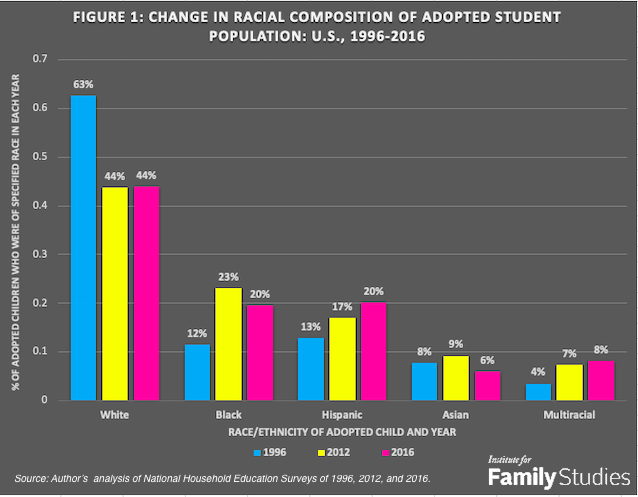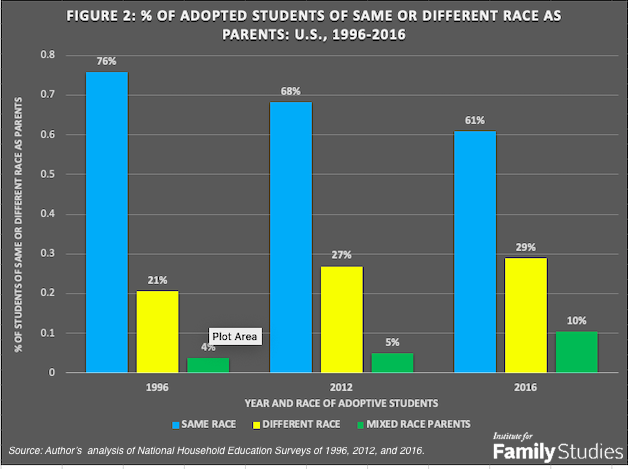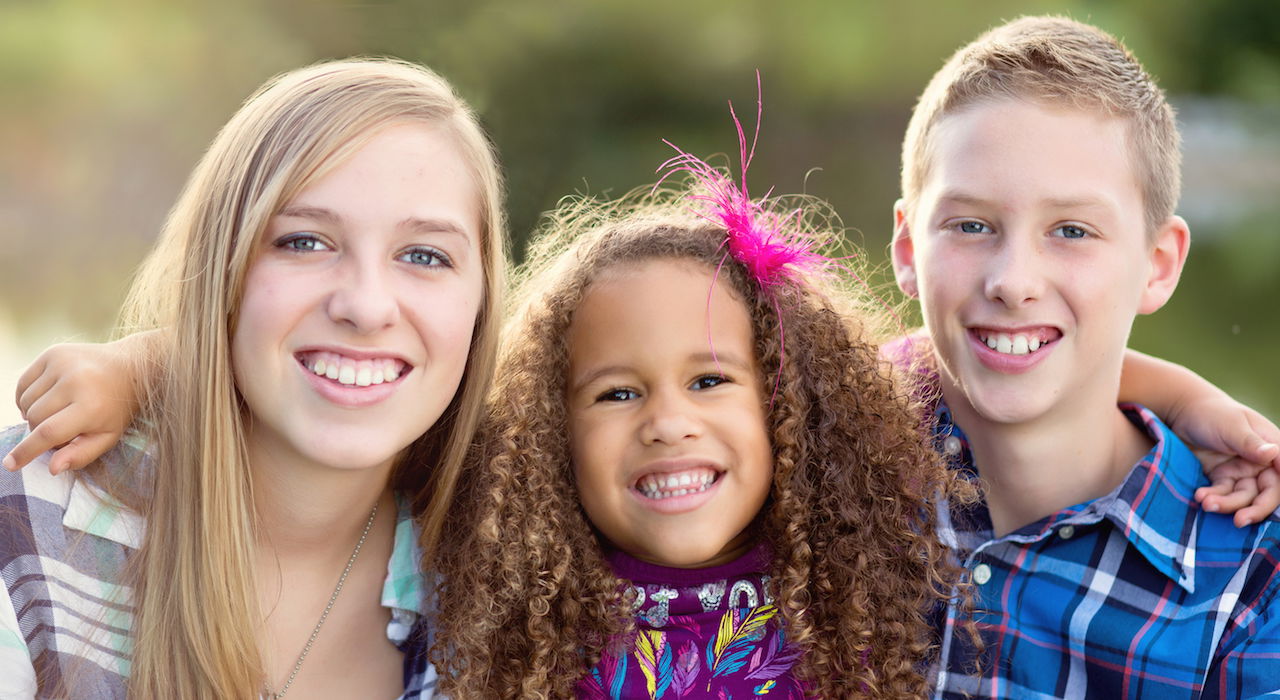Highlights
- Over the 20-year period between 1996 and 2016, the proportion of adopted children who were white fell from nearly two-thirds to less than half. Post This
- The new data confirm a trend noted earlier: the proportion of adopted children who are being raised by parents of a different race from themselves has increased. Post This
In a previous IFS research brief, I reported that the racial and ethnic composition of the adopted child population of the U.S. had changed dramatically in less than a generation. A new analysis of more extensive survey data1 confirms, extends, and partly corrects the trends described in the earlier report. The new evidence, depicted in the figure below, shows that over the 20-year period between 1996 and 2016, the proportion of adopted children who were white fell from nearly two-thirds to less than half.

Over the same period, the proportion of adopted children who were Hispanic nearly doubled, going from 13% to 20%. The proportion who were Black showed a similar increase. This is a change from the earlier brief, which reported an apparent diminution of the Black fraction. But the National Household Education Surveys of 1996, 2012, and 2016, which have larger samples of students and cover a wider age range than the kindergarten longitudinal surveys relied upon earlier,2 show growth in the Black segment of adopted children over the two-decade span. They also show a doubling of the proportion of adopted students who were multiracial, from 4% to 8%. The proportion of adopted children who were Asian fluctuated between 6% and 9% over the same time period.
The new data confirm a trend noted earlier, namely that the proportion of adopted children who are being raised by parents of a different race from themselves has increased. That proportion increased from 21% to 29% between 1996 and 2016, as shown in Figure 2. The proportion adopted by mixed-race couples also increased, going from 4% to 10%. Conversely, the proportion adopted by parents who were of the same race as the child declined from 76% to 61 percent.3

It is primarily white parents who adopt children of a different race or ethnicity than themselves. Whereas 96% of the students adopted by Black parents were Black and 88% of those adopted by Hispanic parents were Hispanic, 68% of the students adopted by white parents were white. The proportion of different race students who had been adopted by white parents increased from 24% in 1996 to 37% in 2016. Three-quarters of all adopted students in 2016 were living with adoptive mothers who were white, whereas 17% lived with Black mothers and 5% with Hispanic mothers.
There are several reasons why these changes have occurred. There continues to be a strong demand for adoptable infants because many couples, especially college-educated ones, have put off trying to have children until their late 30s or early 40s. Some then have difficulty becoming pregnant due to declines in fecundity with age.4 Unable to have children of their own, they turn to adoption as an alternative route to parenthood.5
Meanwhile, the supply of adoptable infants within the U.S. has diminished because of more widespread contraception and readily available abortion among unmarried teenagers and young adults. Between 1990 and 2018, the annual number of births to teenagers in the U.S. dropped by two-thirds, while the teen birth rate dropped by 71 percent.6 However, there are still ample numbers of children in foster care who are available for adoption (almost 125,000 in 2019).7 These children face a more difficult road to adoption, being older (a median age of 8) and often having histories of parental neglect or abuse, drug or alcohol involvement, or mental illness. Despite these challenges, between 51,000 and 66,000 children were adopted from foster care annually during the last decade. Black and multiracial children are overrepresented among youngsters adopted from foster care.8
Some couples and single adults wishing to adopt turn to children from other countries who are in need of permanent homes.9 The availability of adoptable infants from specific countries has varied with changes in some nations’ policies regarding fertility regulation (e.g., China, which discontinued its one-child per couple restriction10 and foreign adoption (e.g., Russia, which stopped allowing adoptions of Russian children by Americans.11 Although international adoptions are not necessarily or intentionally interracial, they often turn out that way, as when white American couples adopt children from South Korea, Nigeria, or Colombia.12 The proportion of adopted students who were born in another country fluctuated between 14% and 18% across the three NHES datasets with year-to-year differences not being statistically reliable. The racial composition of foreign-born adopted students in the 2012 and 2016 surveys combined may be seen in Figure 3. Asian children made up the largest group of adopted students, followed by Hispanic, white, and Black students.

I conclude this update by reiterating statements I made at the end of the earlier research brief, which continue to be appropriate today:
In its current state, adoption helps many childless couples fulfill their parental ambitions and gives many abandoned children the opportunity to be reared in stable, supportive, and financially secure homes. As the data in this research brief shows, adoption is also helping to make the U.S. a more global society, increasing ethnic diversity, and broadening the definition of what it means to be a family. But there are still many children right here in the U.S., such as those in the foster-care system, who might benefit from adoption and are currently being left out of the process. And there are certainly ways in which adoption practices could be improved to better inform and prepare prospective parents to make a lifelong commitment to a child in need of a loving and stable family.
Nicholas Zill is a research psychologist and a senior fellow of the Institute for Family Studies. He directed the National Survey of Children, a longitudinal study that produced widely cited findings on children’s life experiences and adjustment following parental divorce.
1. The estimates presented here are based on analysis of public use data from the National Household Education Surveys of 1996, 2012, and 2016. These were cross-sectional surveys that collected parent reports about national probability samples of students in grades preschool through 12, including those in private schools or being home schooled. The 1996 NHES covered 20,160 students, of whom 334 were adopted. The 2012 NHES, 17,563 students, of whom 442 were adopted. The 2016 NHES, 14,075 students, of whom 417 were adopted.
2. The previous report was based on analysis of the Early Childhood Longitudinal Study of the Kindergarten Class of 2010-2011, which included 227 adopted students, and an earlier, similarly named study of the Kindergarten Class of 1998-1999, which included 252 adopted students.
3. Percentages for same-race and different-race adopteds include both families with two adoptive parents and those with single adoptive parents. Percentages for adopteds with mixed-race adoptive parents are limited to two-parent adoptive families.
4. National Center for Health Statistics. (2015-2017). Impaired fecundity tables. U.S. Centers for Disease Control.
5. Jones, J. (2008). Adoption experiences of women and men and demand for children to adopt by women 18–44 years of age in the United States, 2002. Vital Health Stat, 23(27), National Center for Health Statistics.
6. In 1990, 521,826 infants were born to women aged 15-19 in the U.S., whereas in 2018, the comparable number was 179,871. Over the same period, the teen birth rate fell from 59.9 to 17.4 births per thousand young women.
7. Children’s Bureau, Administration for Children and Families. (2020). Adoption and Foster Care Analysis and Reporting System (AFCARS), Foster Care File 2019. Washington, DC: U.S. Department of Health and Human Services.
8. Zill, N. & Bramlett, M. (2014). Health and well-being of children adopted from foster care. Children and Youth Services Review 40, 29-40.
9. Compton, R. (2016). Adoption beyond borders. Oxford University Press. Selman, P. (2009). The rise and fall of intercountry adoption in the 21st Century. International Social Work. 52 (5): 575–594.
10. Wang, F., Gu, B., & Cai, Y. (March 30, 2016) The end of China’s one-child policy. Washington, DC: The Brookings Institution. https://www.brookings.edu/articles/the-end-of-chinas-one-child-policy/
11. Herszenhorn, D.M. & Eckholm, E. (December 27, 2012) Putin Signs Bill That Bars U.S. Adoptions, Upending Families.
12. U.S. Department of State. (March 2020). Annual Report on Intercountry Adoptions, FY 2019 and previous years. Washington, DC: Author.












